Seven Wrecks You Can Only Dive from a Liveaboard
We dive to explore—to get that high of feeling like the first ones to lay eyes on an underwater find. In the modern world of GPS and social media, it can feel like it’s all been done. Sure, unless you quit your day job, you may not ever discover a never-before-seen wreck, but that doesn’t mean there isn’t magic to be found, especially by those willing to trek to the edge of the map. Out where few ever travel, the experiences still feel virgin. Marine life hasn’t begun to alter its behavior due to human impact. The wrecks out there aren’t ones that you’ve heard stories about. Rather, they’re still outliers, and the journey off the grid to experience them only adds to the overall thrill.
Maru #2
Solomon Islands
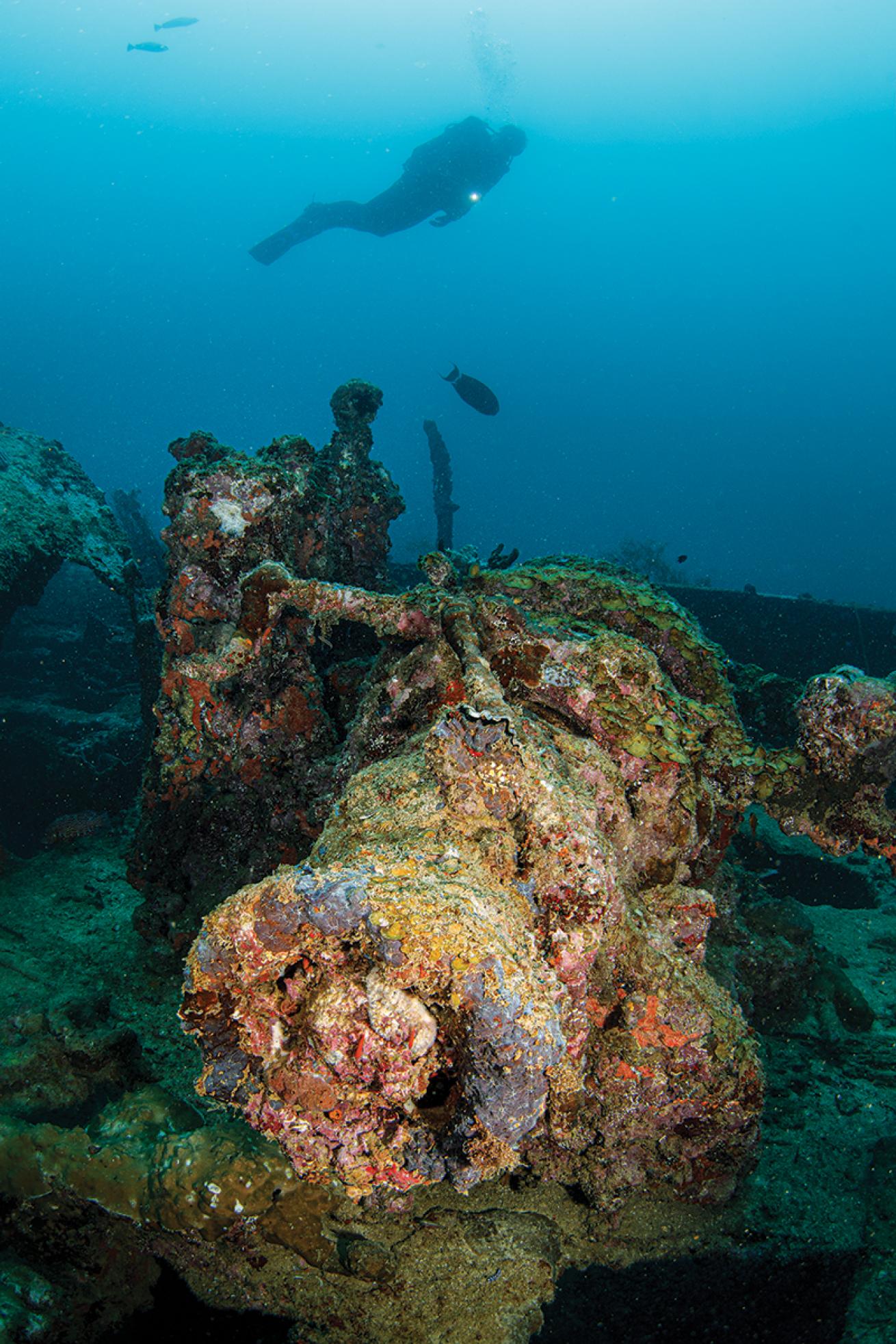
Allison VitskyMaru #2 was at anchorage when U.S. planes bombed it in November 1942.
The Japanese freighter sitting in Marovo Lagoon is so remote that it’s even out of reach of any villages in the Solomon Islands. In fact, it is dived so rarely that it has yet to be officially identified.
“We’ve only ever called it ‘Maru #2’—as far as we know, it has never been officially identified,” says Sam Leeson, owner of the Bilikiki liveaboard, which tours this Oceania nation consisting of nearly 1,000 islands. For this vessel, if they were to travel straight to the site, it’d be a 15-hour motor from Honiara, the capital.
Along with three other freighters, this ship was at anchorage when U.S. planes bombed it in November 1942. It sunk to a depth of 90 feet, where, for nearly 80 years, it has been amassing heaps of black coral and marine life.
“We always see tons of fish that come right up to your face,” says Leeson.
The wreck ushers in life at every level of the food chain: big schools of trevally, barracuda and surgeonfish, as well as mantis shrimp and pygmy seahorses—yes, really. This site delivers the tiniest finds as well as some of the biggest, including manta rays and sharks. Perhaps best of all, the freighter boasts numbers—as in large schools.
“Even if you’re not into wrecks, you’ll still like the big, bushy black corals that attract all the glassfish,” says Leeson.
The big schools of glassand baitfish tend to amp up the bigger predators.
“The trevally are going absolutely crazy when they are hunting on the wreck,” says Leeson. Moreover, because these fish don’t know from nets or hooks, their behavior is different than at many dive sites. They display curiosity and aren’t spooked by divers. Adds Leeson, “There’s so much here, making the wreck consistently good—it’s a good mix with tons of fish, good critters plus the history of a relatively intact wreck that’s been down for 70-odd years.”
How to Dive
The seven-day charters aboard Bilikiki do not travel out to Marovo Lagoon; however, trips that are 10 days or longer do make the journey. The wreck is best experienced on nitrox, available on the boat.
Chikuzen
British Virgin Islands
To dive the Chikuzen is to instantly hail it a favorite.
This 246-foot refrigeration vessel went down in 1981 as hurricane collateral, 7.5 miles northwest of Tortola, between that island and Anegada. In the 40 years it has been down, it has become an isolated oasis, having amassed gardens of coral and sea fans.
“There is nothing around the Chikuzen—nothing—no coral, just a sandy bottom,” says Kevin Purdy with All Star Liveaboards.
With nothing for miles, this ship has become a stopover for the big stuff, such as sharks, eagle rays, loggerhead turtles, amberjack and pelagics.
It’s a dive that delivers, and it’s certainly one that most BVI travelers would want to drop in on, but they’d need to be booked on a liveaboard to get that chance. For a land-based operator to make the trek, the conditions would have to be dead calm, and the entire group would have to want to commit to the more-than-an-hour boat ride. Because of this, land-based operators go maybe once a year.
Drop in, and perhaps the most mesmerizing effect is the thick, glittering rivers of fish, blocking wide swaths of the ship from view—until a shark or pair of eagle rays cuts through, sending fins scattering.
He adds, “For the volume and variety of marine life, there is no better wreck in the BVI.”
How to Dive
Cuan Law, a 105-foot trimaran, visits the site during its weekly charters, weather permitting. Because the wreck sits in 85 feet of water, the crew reminds guests that there is no need to touch the bottom. Rather, save your air and hover around the top deck where most of the action happens. Also keep in mind that because this wreck sits in open water, trips here are weather-dependent. A windy day can kick up waves and drop the visibility substantially.
Numidia
Red Sea
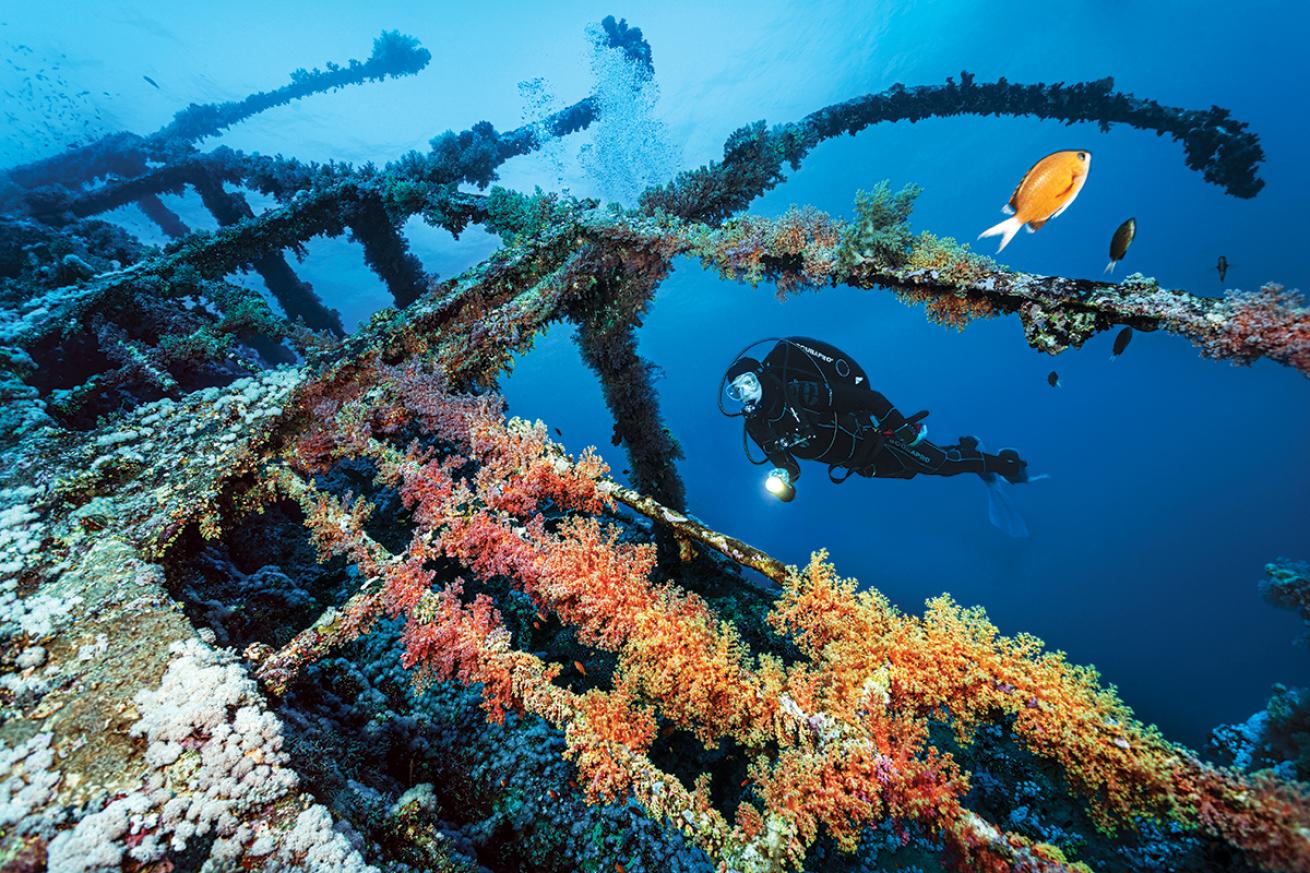
Tobias FriedrichAnything can appear in the open ocean near the Red Sea’s Numidia. Thresher sharks are common.
“Big Brother Island is famous for sharks rather than its wrecks,” says Zoe Jones, dive instructor with the Aggressor fleet, of the pair of rock outcroppings found 25 miles from the Egyptian coast.
The destination’s reputation could stem from two possible reasons.
One, the wreck of the Numidia would be more famous save for one fact. “The Numidia is just as beautiful as other wrecks in the Red Sea,” says Jones of the 140-foot British freighter, but it doesn’t earn the hype because it sunk while carrying no cargo—in other words, there are few artifacts to be seen from its 1901 sinking.
Two, the sharks that favor the site are species that most North American divers get excited about.
Thresher sharks, easily identified by their oversize, scythelike tails, are resident to the wreck at depths of 90 feet and deeper.
“They normally come very close to you,” says Adel M. El Beialy, a cruise director for the Aggressor Fleet’s Red Sea yachts. “If a diver is relaxed, they come and check you out. They stay maybe 10 minutes or so, doing a couple of circles around the divers, and then they leave.”
Most divers also treasure the encounter for the distinct look of the shark.
“They have big, beautiful round eyes,” says El Beialy. “Because of this, some divers call it the fox shark.”
It’s the sort of encounter a diver doesn’t easily forget—nor is it an encounter had by any day-trippers. The dayboats hug the shore, where shark encounters are the stuff of legend.
Out here, it’s open ocean where anything wild can—and does—happen.
How to Dive
Red Sea Aggressor III is the only yacht in the Aggressor Adventures fleet that makes the trip to Numidia. Be sure to choose the southern itinerary that lists the Brother islands as part of the trip. Those who do book need to know that a negative entry is standard to dive Numidia. In other words, it’s a back-roll off of the Zodiac, then an immediate descent to at least 20 feet or so—no popping to the surface after entry, lest you be swept off the site by waves or surface currents.
The landing craft of Manim Island
Indonesia
Rare are the World War II wrecks that went down in action—that is, with guns blazing, battle raging. Instead, many were deliberately scuttled or bombed while at anchor. The seven-landing craft off the coast of Manim Island, Indonesia, however, were in the middle of a mission when they met their fate.
Today, only a handful of dive liveaboards make the trek to the site. From West Papua—the easternmost bit of Indonesia—it’s a motor north to Numfoor Island, then east to its satellite island of Manim.
The whole stretch isn’t famous for the wrecks but for being the world’s epicenter for biodiversity. This stretch of Indonesia is known as the Bird’s Head Peninsula and cradles Cenderawasih Bay.
The wrecks only add to the mystique. Because the island of Numfoor was a Japanese stronghold during WWII, the area also holds a collection of wrecks including a patrol boat, a 213-foot pillbox wreck and the landing crafts, which range in depth from 15 to 75 feet.
“The landing ships are the absolute classic Saving Private Ryan vessels,” says Jamie Maher, co-owner and operator of the Calico Jack liveaboard, which regularly cruises to this area. “It’s a very evocative experience to dive these boats that sunk in action—while fighting.” The wrecks are as much a chance to connect with history as they are a way to encounter the unusual underwater. “The whole bay is an isolated evolutionary pot for geographical reasons,” says Maher.
Cenderawasih is home to a host of endemic, only-there species, including its own walking shark, plus the Papuan garden eel—yellow with brown spots.
Cenderawasih also claims its own species of mantis shrimp as well as the Papuan convict goby, Nursalim flasher wrasse and many more. Plus, the list of just-identified species grows every year.
Says Maher, “For many of us [who work on Calico Jack], Cenderawasih is our top destination on a personal level.”
How to Dive
Calico Jack offers 11-night itineraries to the Cenderawasih Bay area from mid-August to early October.
City of Winchester
Oman
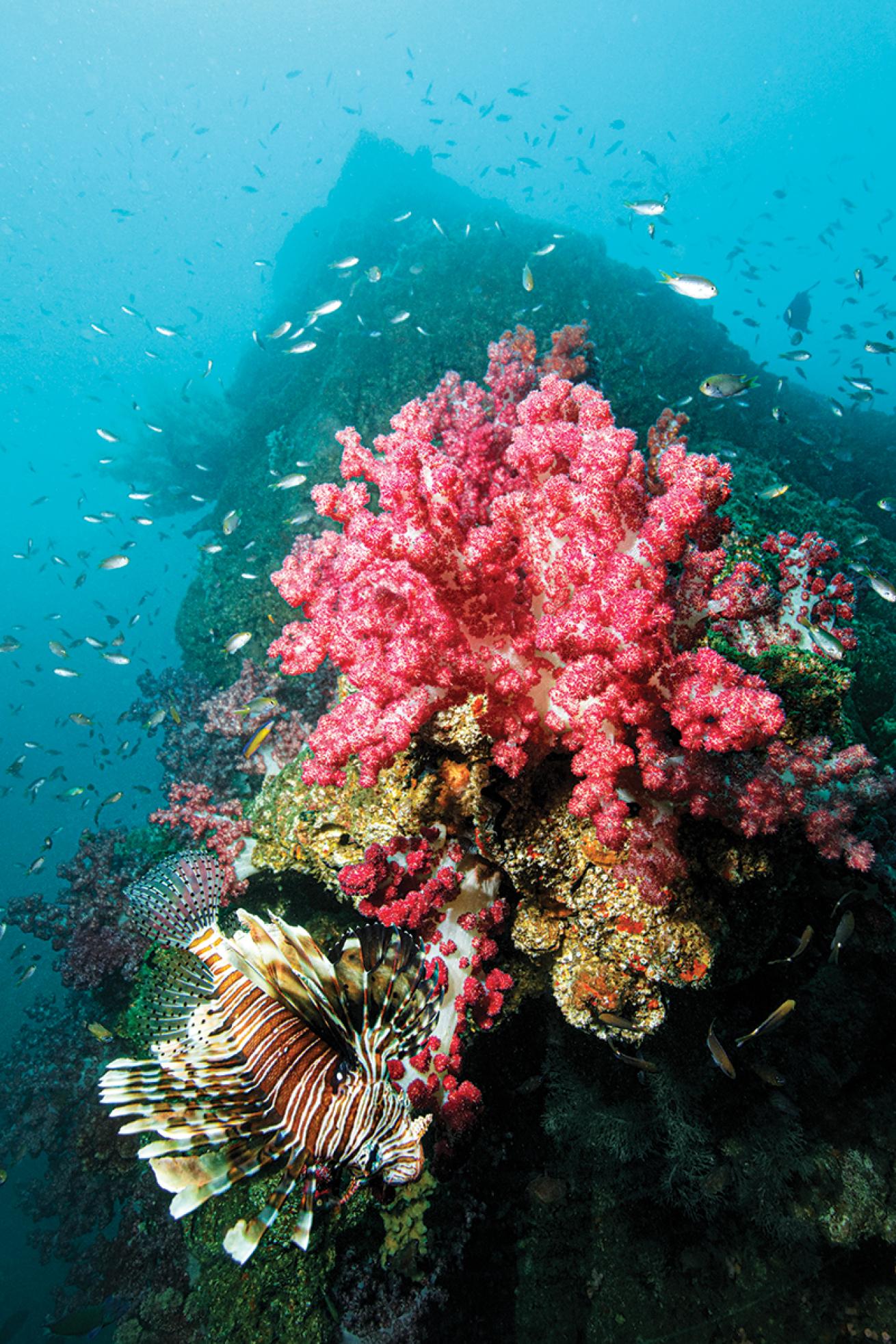
Tobias FriedrichSoft coral Dendronephthya klunzingeri and lionfish find a home on Oman’s City of Winchester.
“There are no other divers going there,” says Shaker Mohamed, cruise director of the Oman Aggressor liveaboard, about the City of Winchester—a 459-foot British cargo ship, sunk during World War I and now divable only by permit from the Oman government.
Not only is access restricted to the site, the wreck was only discovered in the late 1990s. Since its sinking in 1914, it sat, unknown, seen only by dolphins, torpedo rays and swarms of mackerel—which still make up the bulk of the wreck’s visitors.
Part of the reason it remained a mystery is its location. The wreck is remote, requiring an 11- to 12-hour motor sail from the southern coast of Oman to the Hallaniyat Islands, where it sits inside a muck-bottom lagoon.
Today, the wreck stands as a bit of a two-fer, packing the unique chance to dive a relic from the first World War—which some argue is an artificial reef because the Germans scuttled the ship to prevent its further use. Second, it stands as a haven for marine life not found elsewhere in the Arabian Sea.
Yellowtail barracuda school the deck, numbering between 20 and 30.
“Everywhere else, you don’t find this fish schooling,” says Mohamed.
Around the perimeter of the wreck, the muck bottom is worth a tour for all the torpedo and electric rays.
“It’s very easy for them to hide here,” he says. “It’s remarkable how many you will see on one dive.”
The site is also home to the 2-foot honeycomb ray, known for its cream color and black dots—as well as its shyness.
“Anywhere that there are lots of divers, this ray doesn’t show up,” says Mohamed. However, it is seen frequently at the wreck.
So, too, is the double-faced toadfish—found only off the coast of Oman.
There’s so much diversity in this one location. The wreck sees few divers, but those who make the trip see more than their share of marine finds, enough to easily fill more than a few logbook pages.
How to Dive
Oman Aggressor’s southern itinerary visits the Hallaniyat Islands and the City of Winchester. At 92 feet to the sand, it’s not within the limits of an open-water diver. However, the Aggressor dive team can count this as an Adventure Deep Dive for those pursuing a specialty or advanced cert, so that all divers can see the site.
Austin Smith
Bahamas
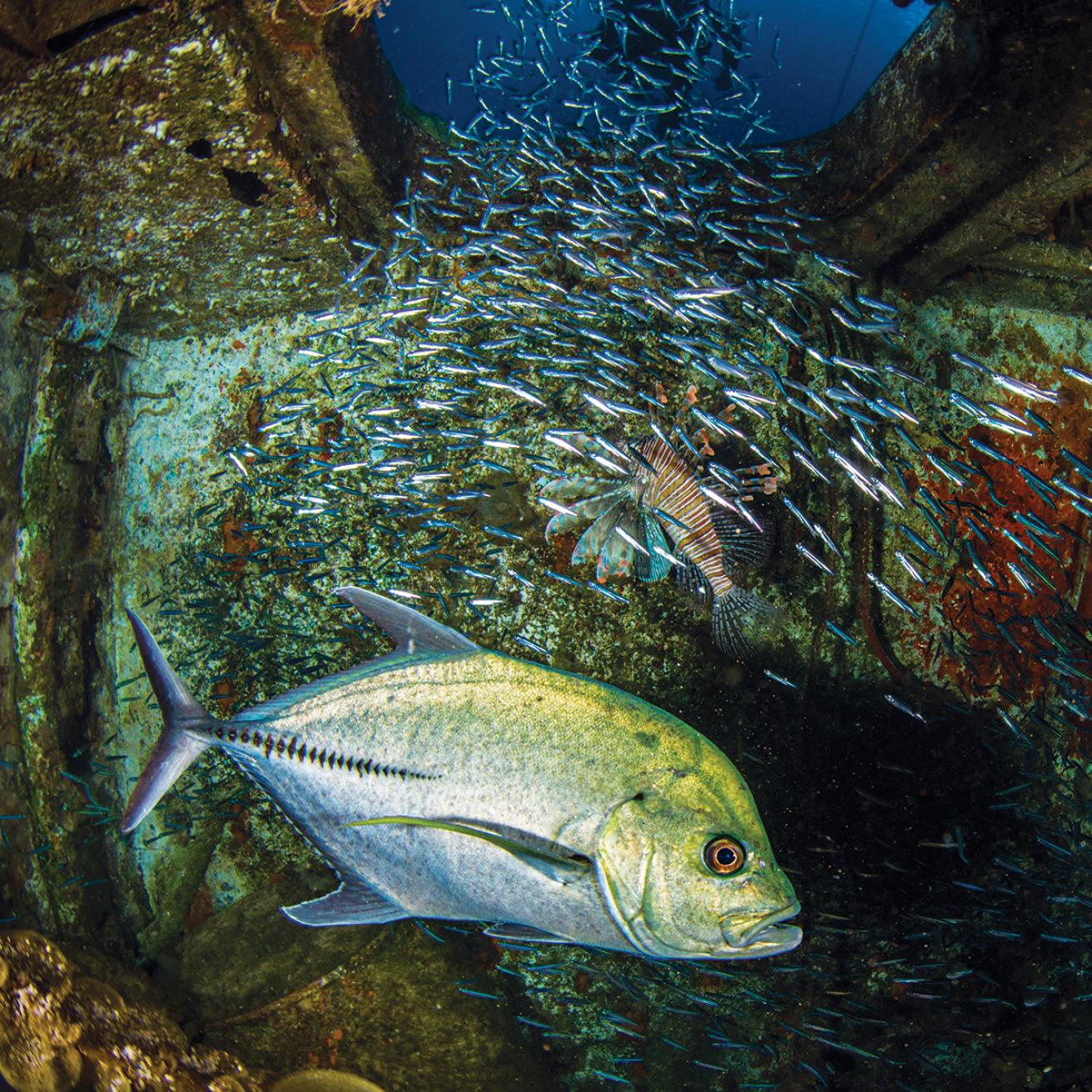
Andy DeitschFish school in the Austin Smith.
“It’s not just that the Austin Smith is out of the reach of day-boats—all of the Exuma Cays are,” says Kevin Purdy of All Star Liveaboards.
The Exumas island chain—most of which is protected as the Exuma Cays Land and Sea Park—sits 131 miles from Nassau, Bahamas. Because of that distance, the destination is visited only by private yachts and diving liveaboards.
Private sailboats and yachts could visit the 90-foot defense force cutter, but most don’t, in large part due to the wreck’s depth.
It sits at 60 feet, causing most snorkelers to overlook this gem.
If they were to jump in and nose around the site, they’d be surprised by the marine life. The All Star boats drop in to the site primarily for the sharks, typically seeing about 12 reef sharks per dive.
“But it’s the Nassau grouper that show the really unique behavior,” says Purdy. “They get right in your face, close enough that you could pet them.”
The grouper aren’t afraid of divers, nor are they afraid of their elasmobranch competition, which includes hammerheads and lemons on occasion. When food is present, as with a passive shark feed, the grouper will get into the action, bumping sharks out of the way.
The grouper also seemingly have learned to recognize the crew, tending to beeline to individuals who visit the site again and again.
It’s just another curious behavior that’s par for the course at this out-of-the-way ship.
How to Dive
All four of the Bahamas-based boats in the All Star fleet aim to visit the wreck weekly, or as weather allows. When at the site, it’s preferable not to approach the grouper, but rather, let them come to you. They display a surprising amount of curiosity, and are more likely to approach those who stay still.
Saratoga
Bikini Atoll
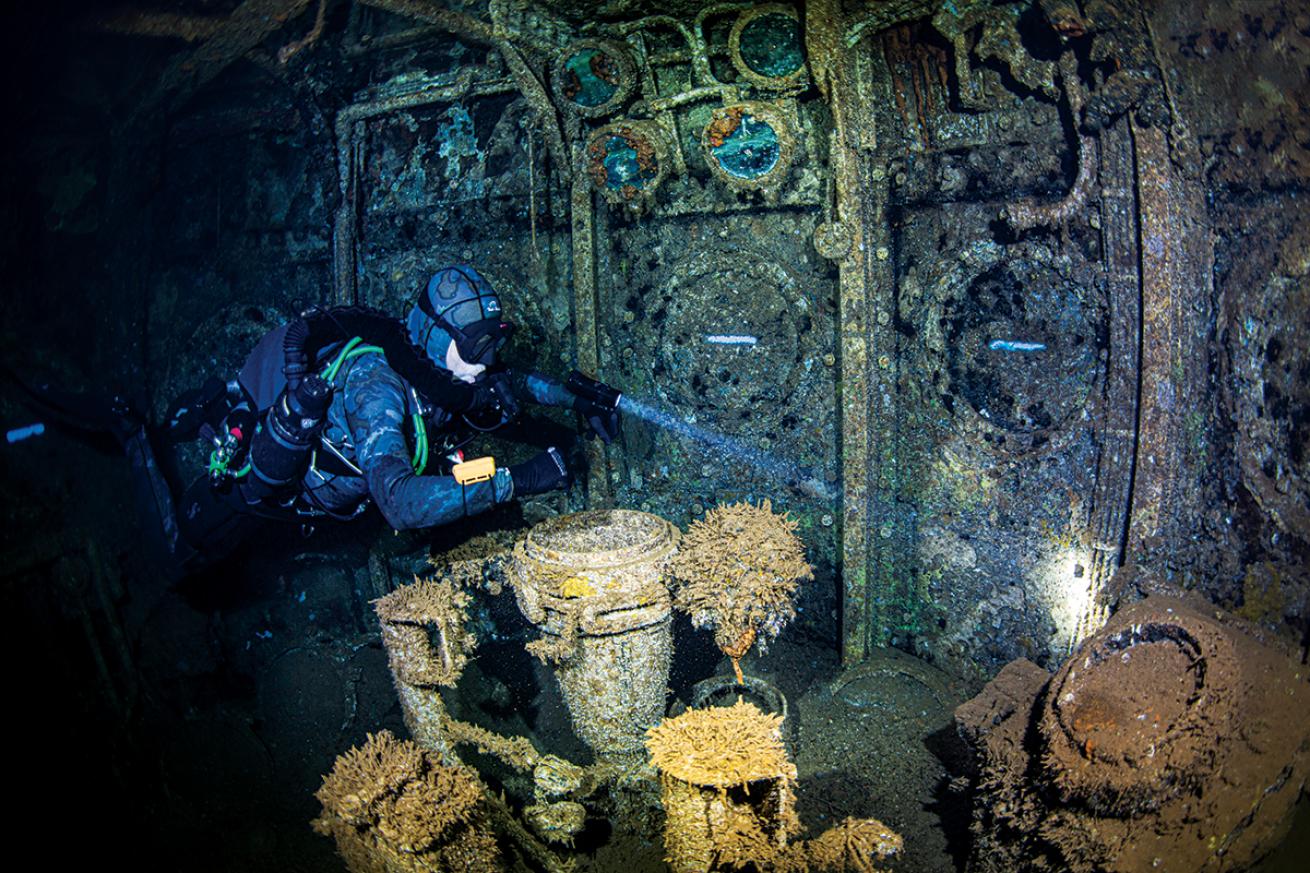
Aron ArngrimssonBikini Atoll’s Saratoga wreck is both a time capsule and a shark magnet.
“Bikini Atoll is a mythical place,” says Craig Johnson, chief officer of the M/Y Truk Master, describing this dive destination that is quite literally in the middle of the Pacific Ocean. It sees crowds of sharks unparalleled by other destinations, and it’s home to one of only three of the world’s divable aircraft carriers, in addition to a handful of other World War II wrecks.
Part of the Marshall Islands—in between Hawaii and Papua New Guinea—Bikini Atoll sits 220 nautical miles from Kwajalein Atoll, the nearest spit of land with an airport. It takes 24 hours by boat to reach Bikini, and that’s if conditions are good. The atoll is famed as the sight of some of the United States’ earliest post-war nuclear tests, during which these ships were purpose-sunk.
The signature wreck of the bunch is the 888-foot USS Saratoga, a Lexington-class aircraft carrier that, along with most of the wrecks of Bikini, sits in sand that’s 170 feet deep, making it accessible only to technical divers.
The wreck itself stands as a proud war relic, well preserved with massive guns, a room full of Coke bottles, a captain’s quarters still containing crockery, a flight-deck elevator and even planes lying out in the sand. Oh, and nine 500-pound bombs are still contained within the ship. Most divers make the trek to witness the collection of wrecks, all of which are warships as opposed to transport or other non-armed-to-the-teeth vessels. For most, it’s simply a bonus that the marine life adds a huge wow factor.
Tiger sharks, some as small as 3 feet and spanning up to 8 feet, crowd the wreck.
“I’ve had one 6 feet behind me, not moving—just looking at me,” says Johnson. “They come up underneath the boat and swim all around us.”
The sharks are an impressive sight, but so too are the schools of red snapper and jacks that they are there to prey upon.
Because the wrecks sit off these islands that are surrounded by nothing but open ocean, each is a hotspot for life—mainly sharks, including silvertips.
It’s an amalgam of many peak experiences: diving an aircraft carrier, being surrounded by sharks and experiencing a far corner of the blue planet where there is nothing—nothing—nearby.
All that, and, “It’s this weirdly special place in American history,” Johnson says.
How to Dive
M/Y Truk Master is the only liveaboard that operates in Bikini Atoll, with 10-, 11- and 14-day charters. To book a trip to this advanced destination, divers must hold at least a Tec 50 certification. You should also be ready for a series of long flights and a day’s layover just to reach Kwajalein Atoll in the Marshall Islands.










